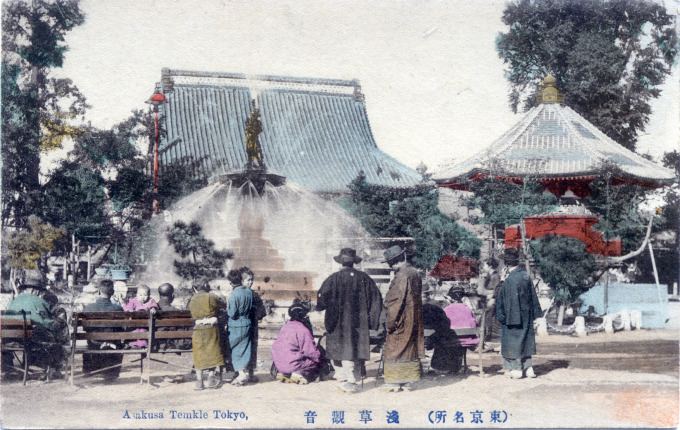
Park and temple visitors gather at the fountain at Asakusa Park, Tokyo, c. 1910, with the back of Senso-ji (Asakusa Kannon) temple in the background.
See also:
Hanayashiki, Asakusa Park, c. 1920
Ryounkaku (Twelve-storeys Tower), Asakusa
Temple of the Goddess of Mercy, Asakusa Sensoji, c. 1910.
“On no account should a visit to [the Asakusa Kannon] and surrounding grounds be omitted; for it is a great holiday resort of the middle and lower classes, and nothing is more striking than the juxtaposition of piety and pleasure, of gorgeous altars and grotesque ex-votos, of dainty costumes and dingy idols, the clatter of clogs, cocks and hens and pigeons strutting about among the worshippers, children playing, soldiers smoking, believer chaffering with dealers of charms, ancient art, modern advertisements – in fine, a spectacle than which surely nothing more motley was ever witnessed within the precincts of a religious edifice.
“… The grounds of Asakusa are the quaintest and liveliest place in Tokyo. Here are raree-shows, penny gaffs, performing photographers, street artists, jugglers, wrestlers, theatrical and other figures (ningyo) in painted wood and clay, aquarium (suizoku-kwan), vendors of toys and lollypops of every sort, and, circulating amidst all these cheap attractions, a seething crowd of busy holiday-makers.”
– A Handbook for Travellers in Japan, Basil Hall Chamberlain, 1901
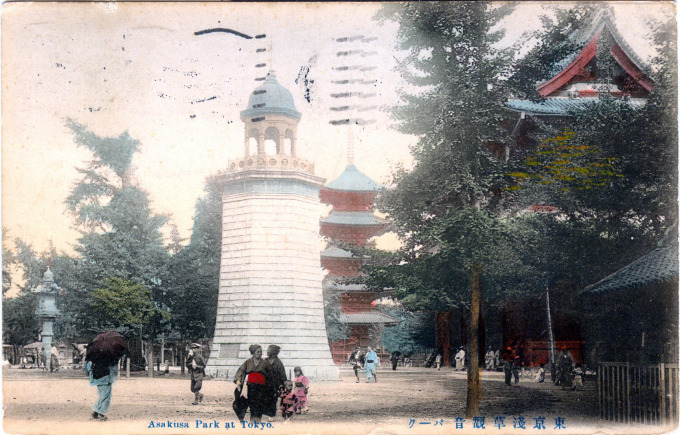
Asakusa Bell Tower, c. 1910. The bell of the Bentenyama bell tower was recast in 1693, and from the Edo era to the end of the Taisho period, it served as the hour bell of Asakusa. The plaque on the bell tower is said to have displayed a poem of Basho, a famous haiku poet: “Ueno or Asakusa, which bell tolls more gaily?”
Asakusa has always been accommodating of both the pious and the profane. A stones’ throw from the licensed red-light district of Yoshiwara, and bordered by a bawdy theater district to its west and the rowdy sideshow atmosphere of Hanayashiki [Flower mansion] to its north, the Asakusa temple grounds served as a magnet for those in search of pleasure – spiritual or sensual – and redemption.
By design or otherwise, the 50-acre Asakusa Park acted as a buffer between the bawdy Rokku theater district and the pious, sedate religious grounds surrounding the Asakusa Kwannon. Early on, Asakusa Park was designated as one of Tokyo’s first five public parks (including Ueno, Shiba, Fukagawa-Kiyosumi, and Asakuyama), so established by the Meiji government in 1873 on appropriated temple grounds.
The northwest corner of the park grounds predated the establishment of Asakusa Park entirely. The privately-owned Hanayashiki opened in 1853 as a flower and bird park. By the turn of the century, Hanayashiki had evolved into a menagerie of hanging gardens, archery galleries, sideshow performers, peep shows, and fortune tellers along with a small zoo.
In 1890, the Ryounkaku [Cloud surpassing pavilion] was erected — no doubt the city’s most impressive skyscraper until the completion of Tokyo Tower in 1958. Ryounkaku would crumble in the 1923 Great Kanto earthquake. Two ponds, Oike [Large pond] and the (ironically) larger Hyotanike [Gourd pond], were created during the Meiji Era west of the Sensoji temple hall and would remain until 1951 when both were filled in. In their place, a covered shopping arcade was built.
- Asakusa Park under snow, c. 1910.
- Theater Street (Rokku), Ryounkaku (Twelve-Storeys Tower), and Asakusa Park, c. 1920.
- Nio-mon Gate (right) and Five-Storied Pagoda, Asakusa, c. 1910. The Sensoji temple would be off to the left.
- Buddha in meditation, Asakusa Park, c. 1920.
- Elevated view of Hanayashiki (left) and the Gourd Pond, from atop the Twelve-Storeys Tower, c. 1920.
- Hanayashiki Garden, at Asakusa Park, Tokyo, c. 1920.
“When a Japanese goes for a day to Asakusa with his family he does not spend much time over his devotions. You can express your needs as a rule in a very few words and Heaven is not so stupid as to require prolonged explanations. There are many objects outside to interest and amuse.
Map: Asakusa Park, showing Nakamise, the temple grounds, Hanayashiki, and the Rokku (Theater Street) amusement quarter. (From Japan: The Pocket Guide, Japan Travel Bureau, 1946.)
“You approach the temple by an avenue of shops [Nakamise] at which you can buy toys, picture books, cakes, and roasted peanuts. Then you pass into the big courtyard where you pause to admire the rich mellow sound of the big bell, whose beautiful tones are said to be due to the fact that when it was being cast the Shogun Iyemitsu himself threw two hundred broad gold pieces into the crucible. As you stand there listening, you will find the ground all around you thick with pigeons who have come flocking around expectant of your charity, for the vast roof of the temple affords nesting room for thousands of these peace-loving birds and there are old women with stalls ready to sell you five rin worth (half a farthing) of peas or beans to throw to them.
“Then you come to the park laid out in 1885 as a recreation ground for the people. On one side is the Hanayashiki, originally a flower garden but now much more of a zoo ,while over against the Hanayashiki is the fishpond teeming with goldfish, with a tea house and a bridge, and in summer an arbour of trailing Wistaria, beautiful to look upon. Beyond the lake on one side is the Aquarium; on the other the great Theatre Street with its row of Dime Shows where you can see a constant succession of feats of jugglery and acrobatic performances. Archery, which is always a favourite pastime with the Japanese, has a special corner for itself, and if you are fond of exercise you may climb to the top of the twelve-storied tower from which you can get a very comprehensive bird’s eye view of the whole city.
“Everywhere you will find the place swarming with itinerant vendors and hawkers with most varied assortments of goods, and you will be obliged to keep a smart look out for pickpockets who are now beginning to know their ways about foreign clothes as well as about the native dress.”
– Every-day Japan, by Arthur Lloyd, 1909


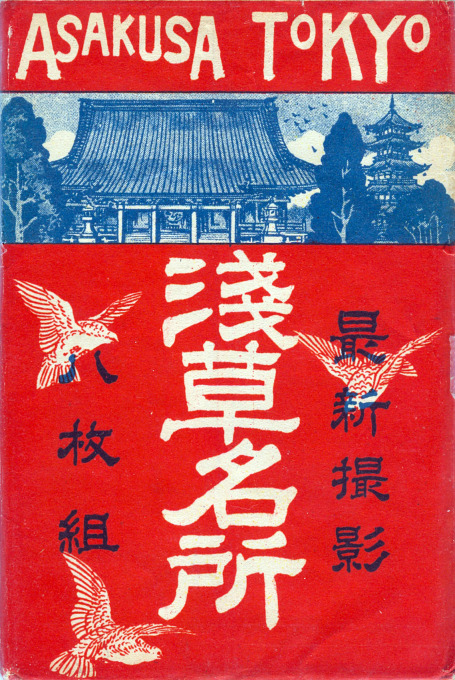
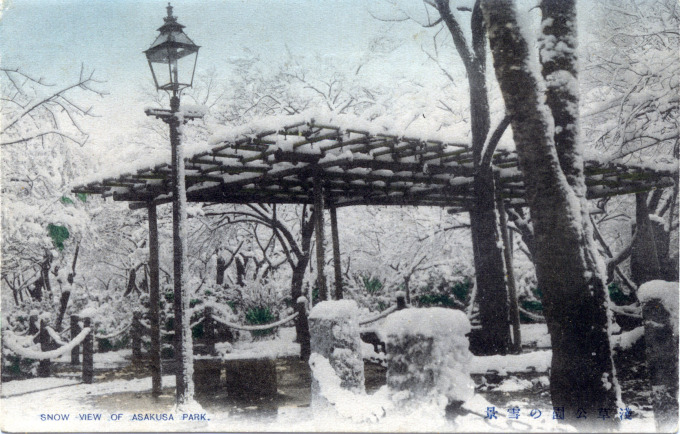
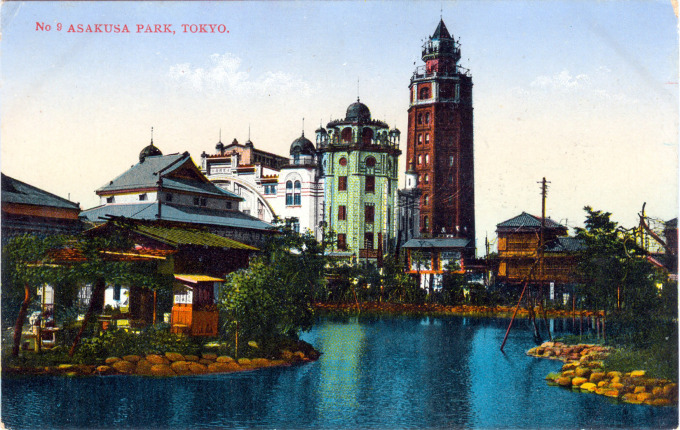
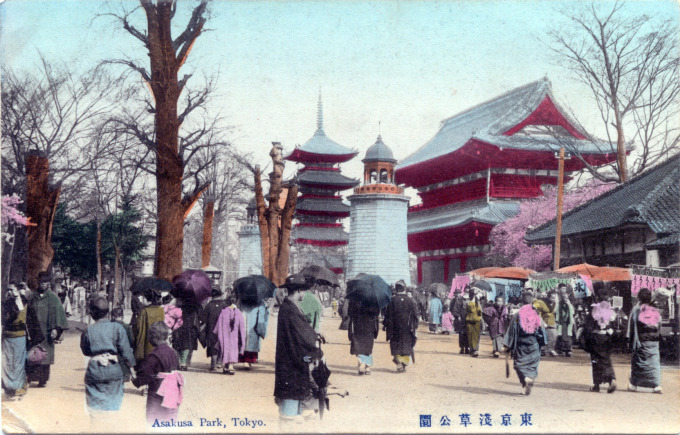
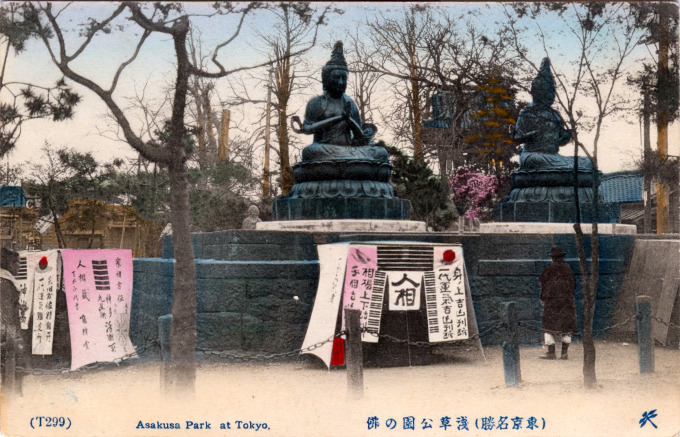
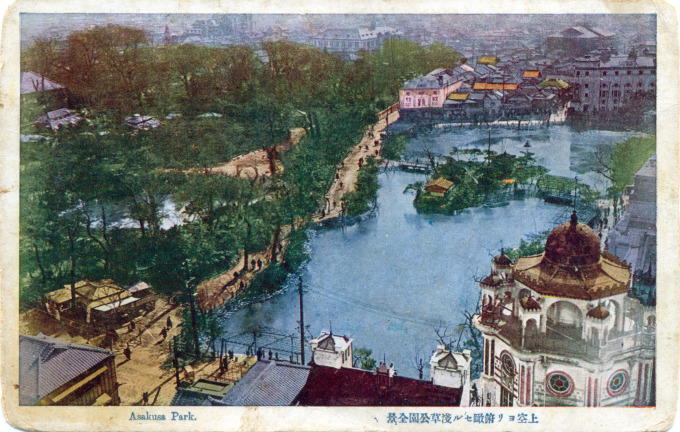
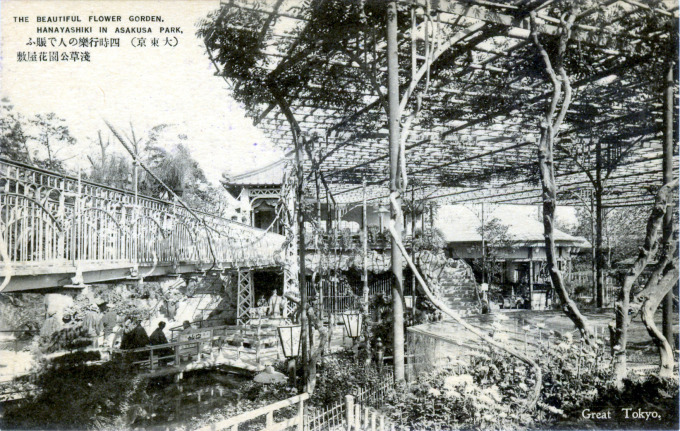
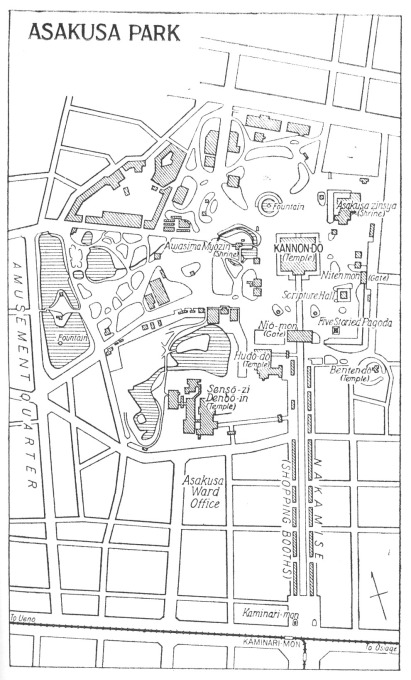
Pingback: Asakusa Rokku (Theater Street), c. 1930. | Old TokyoOld Tokyo
Pingback: Panoramic view of Asakusa, c. 1910. | Old TokyoOld Tokyo